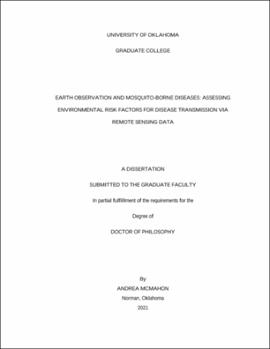| dc.description.abstract | Despite global intervention efforts, mosquito-borne diseases remain a major public health concern in many parts of the world. New strategies to target interventions rely on spatially explicit information about disease transmission risk. Because the transmission of mosquito borne diseases is influenced by environmental conditions, environmental data are often used to predict disease risk. However, the relationships between environmental conditions and such diseases are not homogeneous across different landscapes and requires a context-dependent understanding. The research presented in this dissertation consists of three case studies that used remote sensing data to identify environmental risk factors for mosquito-borne diseases in different geographic settings.
In the first project, the distribution of malaria cases in two study areas in the Amhara region of Ethiopia was analyzed with the help of remote sensing data on land surface temperature, precipitation, spectral indices, as well as land cover and water availability. Environmental variables were derived from remote sensing data and their relationships with spatial and temporal patterns of malaria occurrence were investigated. Settlement structure played an important role in malaria occurrence in both study areas. Climatic factors were also important, with relative risk following a precipitation gradient in the area by lake Tana and a temperature gradient along the Blue Nile River escarpment. This research suggests that studies aiming to understand malaria-environmental relationships should be geographically context specific so they can account for such differences.
Second, the spatial distribution of West Nile virus (WNV) risk in South Dakota was studied via different geospatial environmental datasets. We compared the effectiveness of 1) land cover and physiography data, 2) climate data, and 3) spectral data for mapping the risk of WNV transmission. The combination of all data sources resulted in the most accurate predictions. Elevation, late season (July/August) humidity, and early-season (May/June) surface moisture were the most important predictors of disease distribution. Indices that quantified inter-annual variability of climatic conditions and land surface moisture were better predictors than inter-annual means. These results suggest that combining measures of inter-annual environmental variability with static land cover and physiography variables can help to improve spatial predictions of arbovirus transmission risk.
Third, mosquito populations in Norman, Oklahoma, were analyzed to investigate the influences of land cover and microclimate on the abundance of vector mosquitoes in a heterogeneous urban environment. Remotely-sensed variables, microclimate measurements, and weather station data were used to study patterns of mosquito abundances. Spatial distributions of the two vector species Ae. albopictus and Cx. quinquefasciatus were strongly associated with land cover variables. Impervious surface area positively affected the abundance of both species. Canopy cover was positively associated with the abundance of Cx. quinquefasciatus but negatively with Ae. albopictus abundance. Among all models based on time-varying environmental data, those based on remotely-sensed variables performed best in predicting species abundances. Abundances of both species were positively associated with high temperature and high relative humidity on the trap day, but negatively associated with precipitation two weeks prior to trapping. These results emphasize the great potential for including satellite imagery in habitat analyses of different vector mosquitoes.
The results presented in this dissertation contribute to the understanding of how land cover and geographic context influence the transmission of mosquito-borne diseases. Particularly remote sensing variables capturing static land cover conditions and dynamic measures of vegetation greenness and moisture can explain spatial variation in disease transmission. as well as vector mosquito distribution. Whereas remotely sensed climatic variables like temperature and precipitation influenced gradients in malaria cases at a regional scale, they explained mostly seasonal variation in mosquito distribution at a city scale. Over-all, freely available remote sensing data can help us understand the environmental determinants of disease distribution and can be a valuable tool for predicting disease dynamics on a landscape scale. | en_US |

